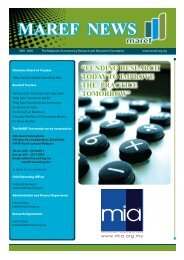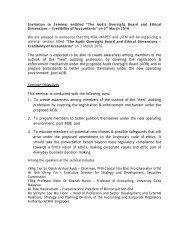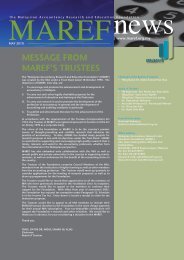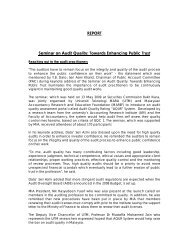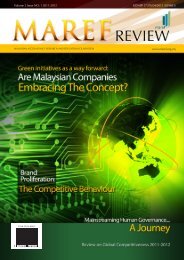Audit Quality Control: Development of Self-Assessment - Malaysian ...
Audit Quality Control: Development of Self-Assessment - Malaysian ...
Audit Quality Control: Development of Self-Assessment - Malaysian ...
Create successful ePaper yourself
Turn your PDF publications into a flip-book with our unique Google optimized e-Paper software.
The structure <strong>of</strong> the checklist consists <strong>of</strong> two parts(refer figure 2). The first part presents questionson the policy and procedures and the second partpresents questions regarding the practices.PartPolicy andProceduresExplanationThe part presents the questions onthe policy and procedures on eachelements <strong>of</strong> ISQC 1. Thequestions shall be answered using“YES” or “NO” option.5.0 SCORE ASSESSMENTAn extension on this checklist is the development<strong>of</strong> score assessment. The score assessment wouldbe weighted according to the importance <strong>of</strong> eachdimension as well as the type <strong>of</strong> questions (eitherpolicies and procedures or practices). <strong>Audit</strong> firmsmay receive scores for each dimension as shownin Figure 4.PracticesThe part comprises <strong>of</strong> questionson the practices <strong>of</strong> each elements<strong>of</strong> ISQC 1. Each indicator shallbe answered using four-scaleoptions.Figure 2: ISQC1 <strong>Self</strong>-assessment checklist -formatEthical RequirementClient RelationshipsLeadership109876543210DocumentationMonitoringQuestions on the practices shall be answeredusing four different indicators. The scale enablesthe audit firm to assess the degree to whichpractices and/or processes are in place thatindicate adherence to the indicators. The auditfirm may choose if the practices and/or processesare highly functional in the firm, operational,emerging or not evident (refer to figure 3). Thefirm should use the scale as an opportunity to askitself challenging questions and to respond withaccurate answers geared toward selfimprovement.IndicatorExplanationNot evident No evidence/ documentationexistsEmerging Evidence indicates early orpreliminary stages <strong>of</strong>implementation <strong>of</strong> practiceOperational Evidence indicates practicesand procedures are activelyHighlyfunctionalimplementedEvidence indicates practicesand procedures are effectivelyand consistently implementedFigure 3: <strong>Self</strong>-assessment checklist - Definitions<strong>of</strong> scaleBased on the discussion with the practitioners, thefinalized questions for each dimension wereagreed consensusly. Details <strong>of</strong> the question itemsare shown in Appendix 2.Human resourcesEngagementPerformanceFigure 4: ISQC1 <strong>Self</strong>-assessment scoreOnce the determination <strong>of</strong> the scores <strong>of</strong> eachdimensions has been calculated, audit firms willreceived the overall score. This score is rankedinto five different scales (refer to Figure 5). Theoverall assessment score indicates the firm’soverall assessment <strong>of</strong> meeting the ISQC 1.Level <strong>of</strong> achievementGood to best practice in manyareasGood to best practice in at leastone areaScore91-100%81-90%Meets minimum standards 71-80%Needs significant improvement inat least one areaNeeds significant improvement inmany areasFigure 5: Overall score assessment61-70%0-60%5





